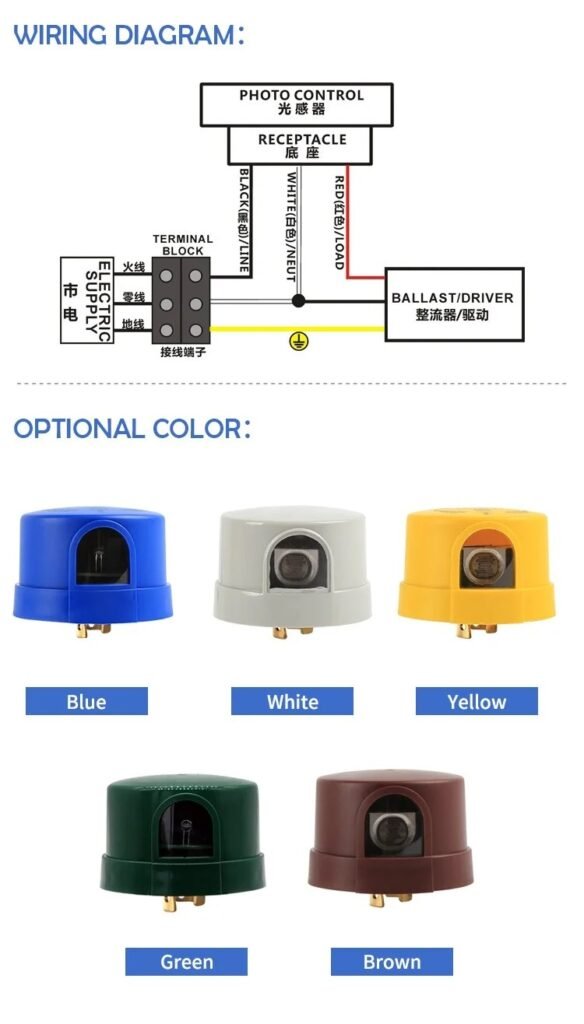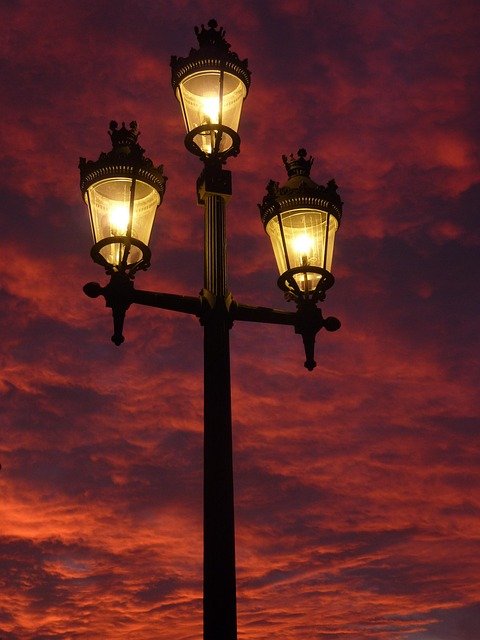Как выбрать соответствующие требованиям и экономически эффективные фотоэлементы для муниципальных тендерных проектов?
Чтобы сделать правильный выбор, муниципалитеты должны сбалансировать соответствие нормативным требованиям с долгосрочной ценностью. Соответствующий фотоэлемент должен соответствовать ключевым международным стандартам, таким как UL773 и ANSI C136.10/41, а также обеспечивать проверенную долговечность, защиту от перенапряжения и устойчивость к окружающей среде.
Руководство по решениям UL773, ANSI C136.10/41 и Lead-Top
Поскольку города модернизируют и расширяют свою интеллектуальную инфраструктуру уличного освещения, муниципальные торги стали более строгими. Менеджеры по закупкам и подрядчики проектов теперь должны учитывать не только цену, они должны гарантировать соответствие, долговечность, сертификацию и долгосрочную надежность.
Выбор фотоэлемента, соответствующего международным стандартам и способного выдерживать полевые условия в течение нескольких лет, может решить исход или провал проекта. В этом руководстве мы рассмотрим ключевые моменты принятия решений, а также расскажем о конкретных продуктах Lead-Top's сертифицированная линейка контроллеров.

Сертификация — ключ к квалификации
Прежде чем фотоэлемент будет рассмотрен на предмет участия в муниципальном тендере, он должен соответствовать признанным в отрасли стандартам сертификации, гарантирующим безопасность, производительность и долгосрочную надежность.
Почему важны стандарты серий UL773 и ANSI C136?
В большинстве североамериканских и международных тендеров соблюдаются стандарты UL773, ANSI C136.10 и ANSI C136.41 — это базовые требования. Без этих сертификатов ваш продукт будет дисквалифицирован, независимо от того, насколько низкой будет ваша цена или быстрой будет ваша доставка.
- UL773 гарантирует электробезопасность, огнестойкость и долговечность фотоэлектрических устройств. Датчики, используемые в наружных светильниках. Он подтверждает, что фотоэлемент Переключатель надежно функционирует при рабочих нагрузках и переменных температурах.
- ANSI C136.10 определяет требования к физической совместимости и производительности для фотоэлементов на базе NEMA, охватывая Интерфейсы 3-контактные, 5-контактные и 7-контактные. Эти стандартизированные соединения гарантируют, что ваши фотоэлементы будут подключаться к существующим светильникам без перемонтажа или модификаций.
- ANSI C136.41 особенно важен для интеллектуального городского освещения; этот стандарт регулирует диапазон 0–10 В и DALI-диммирование протоколы через 7-контактные фотоэлементы. Выбор датчика освещения с фотоэлементом, совместимого с ANSI C136.41, подготавливает вашу систему к интеллектуальному дистанционному управлению, Интеграция Интернета вещейи оптимизация энергопотребления.
Контроллеры фотоэлементов Lead-Top полностью сертифицированы по UL773, ANSI C136.10 и C136.41.
Многие модели также поддерживают Zhaga Book 18, что делает их идеальными для современных интеллектуальных столбов.
Оценка соотношения затрат и производительности
Помимо соответствия требованиям сертификации, по-настоящему экономически эффективный фотоэлемент должен демонстрировать высокие технические характеристики по многим параметрам, которые влияют на реальную надежность и ценность жизненного цикла.
Четыре показателя, которые имеют значение при выборе фотоэлемента
Недостаточно выбрать самый дешевый фотоэлемент. Муниципальные проекты уличного освещения требуют глубокой оценки производительности продукта, особенно для 5–10-летних контрактов. Ниже приведены четыре наиболее важных параметра производительности:
а) Защита от перенапряжения
Системы наружного освещения часто подвергаются воздействию напряжения шипы, молния скачки напряжения или сетка шум. Недостаточная защита от перенапряжения может повредить как фотоэлемент, так и светодиодный драйвер.
Рекомендуется:
- Минимум: 10кВ / 5КА
- Идеал: 20кВ / 10КА
LT134 и LT154 от Lead-Top оснащены защитой от перенапряжения 20kV/10KA. Эти фотоэлементы обеспечивают устойчивость, необходимую в нестабильных сетей или регионов, подверженных ударам молний, что сокращает количество вызовов по техобслуживанию и замен.

б) Обнаружение перехода через нуль
Традиционные фотоэлементы могут создавать броски тока ток и искрение при переключении случайных фаз переменного тока. Это изнашивает внутренние реле и нагружает драйвер светодиода.
Обнаружение перехода через ноль гарантирует, что переключение происходит, когда напряжение пересекает ноль, исключая искрение и продлевая срок службы системы. Используется в LT134 и LT154 компании Lead-Top Серия, эта технология улучшает электрические срок службы и сокращает число обращений за техническим обслуживанием.
в) Прочность переключения
Долговечность определяется тем, сколько циклов включения/выключения может выполнить фотоэлементный переключатель до отказа. Муниципальные проекты требуют долгосрочной стабильности.
LT154 и LT134 рассчитаны на более чем 10 000 циклов ВКЛ/ВЫКЛ. Это делает их идеальными для многолетних проектов общественного освещения, где надежность имеет решающее значение.
г) Экологическая устойчивость
Проекты городского освещения реализуются в разнообразных, часто суровых климатических условиях. Рассмотрите следующие характеристики:
| Спецификация | Рекомендуемый минимум |
| Рабочая температура | от –40°С до +70°С |
| Защита от проникновения | IP66/IP67 |
| Огнестойкость | UL94 V-0 |
| Материал корпуса | Поликарбонат, устойчивый к УФ-излучению |
Они обеспечивают работу в прибрежных зонах, засушливых пустынях, влажных тропических лесах и в условиях сильного загрязнения городской среды.
Компания Lead-Top предлагает модели со степенью защиты IP66/IP67 с ударопрочным корпусом, устойчивым к УФ-излучению, и огнестойким корпусом UL94.
Представленный продукт: LT134 – создан для муниципальных тендеров
Среди широкого ассортимента фотоконтроллеров компании Lead-Top, LT134 выделяется как лучшее в своем классе решение для проектов городского освещения:
| Особенность | Спецификация |
| Сертификация | ANSI C136.10 + УЛ773 |
| Диапазон напряжения | 120–277 В переменного тока |
| Совместимость | 120-277 В для светодиодных, газоразрядных и вольфрамовых нагрузок |
| Защита | 20кВ/10КА импульс, Корпус IP67, устойчив к УФ-излучению |
| Технологии | Обнаружение перехода через ноль, датчик ИК-фильтра, герметичное реле |
| Прочность | 10 000+ циклов переключения |
| Гарантия | 8 лет |
Независимо от того, предполагает ли ваш проект модернизацию устаревшей инфраструктуры или строительство «умного города» с нуля, LT134 разработан для обеспечения безопасного, стабильного и масштабируемого управления освещением, что делает его надежным выбором для победы в муниципальных тендерах.
Дополнительные преимущества:
- Полностью настраиваемый дизайн (цвет, этикетка, логотип) для брендинга проекта
- Доступно в версиях NEMA 3-контактный, 5-контактный, 7-контактный и Zhaga Book 18
- Идеально подходит для использования в Латинской Америке, Северной Америке, на Ближнем Востоке и в Юго-Восточной Азии.

В конкурентном мире муниципальных торгов фотоэлементы являются небольшим, но критически важным компонентом. Некачественные или несертифицированные модели могут привести к дисквалификации тендера, раннему отказу системы, высоким расходам на техническое обслуживание и пропущенным гарантийным претензиям.
Заключение
Успех в тендерах на муниципальное освещение зависит не только от цены, но и от выбора компонентов, которые обеспечивают проверенное соответствие требованиям, производительность и ценность с течением времени.
Победа в муниципальных проектах начинается с более разумного выбора компонентов
Напротив, выбор сертифицированного, высокопроизводительного датчика освещения на основе фотоэлемента, такого как LT134 от Lead-Top, дает вашему предложению:
- Конкурентное преимущество в квалификации
- Более высокая производительность жизненного цикла
- Более низкая общая стоимость владения
- Готовность к модернизации «умного города»
Несмотря на небольшие размеры, фотоэлементы являются важнейшими компонентами любой системы наружного освещения. Выбор поставщика, такого как Lead-Top, с полной сертификацией, прочной конструкцией и доказанной надежностью, дает вам конкурентное преимущество в муниципальных торгах и долгосрочный успех проекта. Независимо от того, нужно ли вам 500 единиц или 50 000, Lead-Top предлагает сертифицированные, настраиваемые и экономически эффективные решения, которые помогут вам выиграть и сохранить муниципальные контракты на освещение.
Ссылки
- https://leaditop.com/product/outdoor-automatic-daylight-sensor-switch-for-led-light/?_gl=1*809b90*_up*MQ..*_ga*MTExNDIyNDQwMS4xNzQ5Mzc5Njc5*_ga_S4H39S96GX*czE3NDkzNzk2NzUkbzEkZzAkdDE3NDkzNzk2NzUkajYwJGwwJGgxNzE4NzAxNzg.
- https://leaditop.com/product-2/
- https://leaditop.com/product-category/product/zhaga-control/
- https://en.wikipedia.org/wiki/Digital_Addressable_Lighting_Interface
- https://en.wikipedia.org/wiki/Internet_of_things







